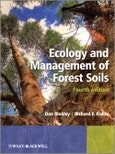Forest soils are the foundation of the entire forest ecosystem and complex, long–term interactions between trees, soil animals, and the microbial community shape soils in was that are very distinct from agricultural soils. The composition, structure, and processes in forest soils at any given time reflect current conditions, as well as the legacies of decades (and even millennia) of interactions that shape each forest soil. Reciprocal interactions are fundamental; vegetation alters soil physical properties, which influence soil biology and chemistry, which in turn influence the growth and success of plants. These dynamic systems may be strongly influenced by intentional and unintentional management, ranging from fire to fertilization. Sustaining the long–term fertility of forest soils depends on insights about a diverse array of soil features and changes over space and time.
Since the third edition of this successful book many new interests in forest soils and their management have arisen, including the role of forest soils in sequestering carbon, and how management influences rates of carbon accumulation. This edition also expands the consideration of how soils are sampled and characterized, and how tree species differ in their influence on soil development.
Clearly structured throughout, the book opens with the origins of forest soil science and ends with the application of soil science principles to land management. This new edition provides:
- A completely revised and updated Fourth Edition of this classic textbook in the field
- A coherent overview of the major issues surrounding the ecology and management of forest soils
- Global in scope with coverage of soil types ranging from the tropical rainforest soils of Latin America to the boreal forest soils of Siberia
- New chapters on Management: Carbon sequestration; Evidence–based approaches and applications of geostatistics, GIS and taxonomies
- A clear overview of each topic, informative examples/case studies, and an overall context for helping readers think clearly about forest soils
- An introduction to the literature of forest soil science and to the philosophy of forest soil science research
This coherent overview of the major issues surrounding the ecology and management of forest soils will be particularly useful to students taking courses in soil science, forestry, agronomy, ecology, natural resource management, environmental management and conservation, as well as professionals in forestry dealing with the productivity of forests and functioning of watersheds.
Table of Contents
Preface, ixAcknowledgments, xi
In Memoriam, xiii
PART I INTRODUCTION TO FOREST SOILS, 1
1 History of Forest Soil Science and Management, 3
2 Global Patterns in Forest Soils, 8
PART II COMPOSITION OF FOREST SOILS, 21
3 Soil Formation and Minerals, 23
4 Soil Organic Matter, 39
5 Water, Pore Space, and Soil Structure, 58
PART III LIFE AND CHEMISTRY IN FOREST SOILS, 75
6 Life in Forest Soils, 77
7 Forest Biogeochemistry, 99
8 Chemistry of Soil Surfaces and Solutions, 138
PART IV MEASURING FOREST SOILS, 157
9 Sampling Soils Across Space and Time, 159
10 Common Approaches to Measuring Soils, 175
PART V DYNAMICS OF FOREST SOILS, 189
11 Influence of Tree Species, 191
12 Soil Management – Harvesting, Site Preparation, Conversion, and Drainage, 213
13 Fire Influences, 235
14 Nutrition Management, 254
15 Managing Forest Soils for Carbon Sequestration, 276
PART VI THINKING PRODUCTIVELY ABOUT FOREST SOILS, 289
16 Evidence–Based Approaches, 291
References, 305
Index, 343








